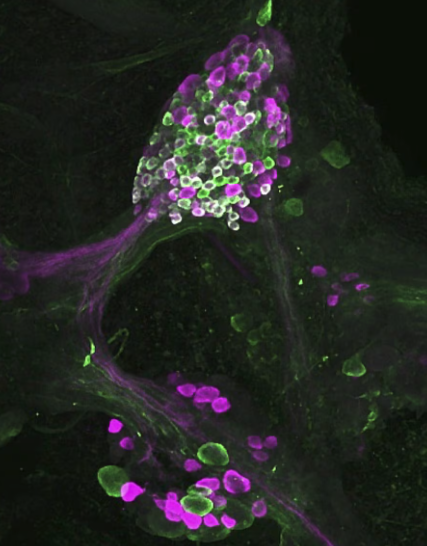Capturing the Invisible: Nikon Center of Excellence in Puerto Rico Celebrates 10 Years
Submitted on 29 September 2025 - 10:26am
This article is reproduced by CienciaPR with permission from the original source.
CienciaPR Contribution:
Original Source:
By:

The Neuroimaging and Electrophysiology Facility at the Molecular Sciences Research Center of the University of Puerto Rico is one of just 30 centers worldwide certified by Nikon Instruments.
At first glance, it’s hard to discern what it is; among the bright tones of blue, violet, and green against a black background lie details invisible to the naked eye. The image, which could easily be mistaken for a piece of art, depicts mechanosensory neurons in the eye of a fly and was captured at the Neuroimaging and Electrophysiology Facility (NIEF) of the Molecular Sciences Research Center at the University of Puerto Rico (UPR). This year, the facility celebrates a decade as a certified Nikon Center of Excellence (CEN).
The CEN, established at NIEF in November 2014 through a strategic collaboration with Nikon Instruments, houses advanced microscopes capable of detecting fluorescent light and exceeding the physical resolution limit. “What does that mean? It means they use fluorescence to mark structures in the samples, and because the light they’re using is fluorescent light, they can see things as small as 100 nanometers apart,” explained Bismark Madera Soto, confocal microscopy specialist.
Since its opening, the CEN has contributed to more than 140 scientific publications, the development of patents, the acquisition of millions of dollars in federal funding, and the training of a new generation of Puerto Rican researchers.
“It’s important to highlight the impact this has on research at the University of Puerto Rico. An international center, recognized by all these grants, the impact it has on student training—that’s so important. Its role in generating publications, intellectual property, this is emblematic for the University. Not every university can have a center like this,” emphasized Dr. José Lasalde Dominicci, director of NIEF.
“Having this company’s recognition for a Center of Excellence has real merit, so, for me, it’s an example of what the University of Puerto Rico is capable of when it brings together the talent of all its researchers to work collectively toward a purpose,” he added.
The establishment of the CEN in Puerto Rico was intended to strengthen microscopy services—research methods carried out through microscopes—across the archipelago and the Caribbean. Lasalde Dominicci recalled that at the time, the local CEN was the thirteenth in the world. Now, there are 30, in countries including the United States, Canada, Germany, India, Italy, South Korea, and Japan.
Since then, the CEN has consolidated itself as a driver of innovation in advanced microscopy, positioning the archipelago as a regional reference point in bioimaging. It has also opened access to cutting-edge technology for researchers and students, strengthening scientific capacity and connecting the island with international research networks.

Madera Soto highlighted the achievement of maintaining the operation of the CEN over the past decade, noting that the requirements to keep it running come with significant challenges.
“The most important thing for the company is the annual investment needed to have state-of-the-art equipment. The certification (as a CEN) is renewed every two years, so there must be a $1 million purchase every two years to maintain that certification. To keep it, you have to demonstrate direct impact, you have to invest in the most up-to-date equipment on the market, and it entails a fairly onerous sacrifice. There are other Nikon Centers of Excellence that have lost their status because they cannot keep up with that pace. We’ve managed to sustain it for 10 consecutive years and are currently in the process of renewing it for another two,” he explained.

For both interviewees, one of the most important aspects of the CEN is its capacity to train the next generation of Puerto Rican scientists, as well as its direct support for graduate students in developing their master’s and doctoral theses. To this, Madera Soto added an outreach program with workshops for students who are not yet at the university level.
“It’s very important to point out that, with this center in Puerto Rico, we have access to state-of-the-art microscopy. For the University and for Puerto Rico, this represents the opportunity to train our students and researchers without having to travel abroad. It strengthens local research and, above all, our ability to compete for federal funding. Even more importantly, it positions the island as a regional scientific hub open to international collaborations,” added Lasalde Dominicci.







